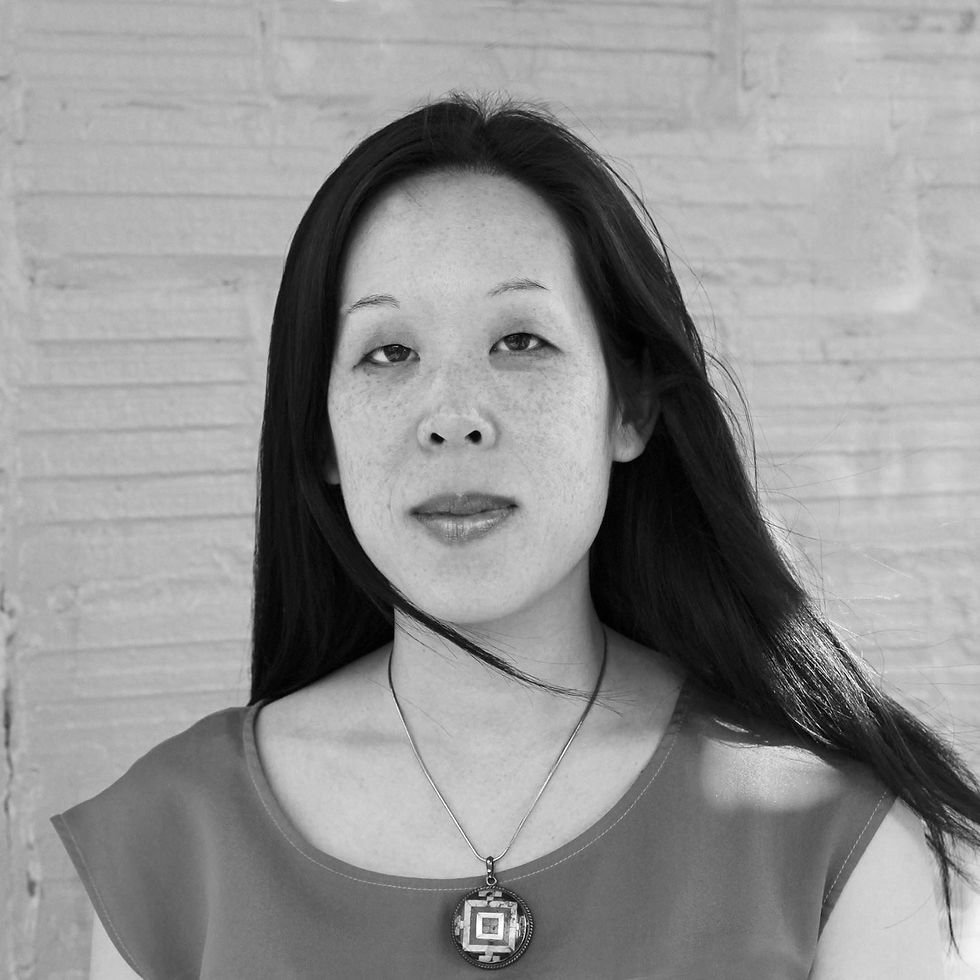August Feature: Shin Yu Pai
- blueshiftjournal

- Aug 14, 2016
- 6 min read

We are proud to have Shin Yu Pai as our featured artist of August!
Shin Yu Pai is a 2014 Stranger Genius Award nominee and the author of eight books of poetry. Her work has appeared in publications throughout the U.S., Japan, China, Taiwan, The United Kingdom, and Canada. Poems have been commissioned by the Dallas Museum of Art twice and her work is also featured in the Poetry-in-Motion Program sponsored by DART. She has been a featured presenter at national and international literary festivals including the Geraldine Dodge Poetry Festival and the Montreal Zen Poetry Festival. In 2010, she became a member of the Macondo Workshop for Writers. Her essays and nonfiction writing have appeared in Tricycle, YES! Magazine, The Rumpus, City Arts, The Stranger, Medium, Thought Catalog, International Examiner, Ballard News-Tribune, Seattle Globalist, and ParentMap. She is founding editor of Lawrence & Crane Publications.
Shin Yu’s visual work has been exhibited work at The McKinney Avenue Contemporary, The Paterson Museum, The American Jazz Museum, The Three Arts Club of Chicago, Center for Book and Paper Arts at Columbia College Chicago, and the International Print Center. She is a member of the Mother Load collective.
Shin Yu has served as a poet-in-residence for the Seattle Art Museum and is a three-time fellow of the MacDowell Colony. As an independent events producer, she has curated literary programming for On the Boards, The Crow Collection of Asian Art, The Women’s Museum of Dallas, and The Rubin Museum of Art. She is former assistant curator for the Wittliff Collections.
Shin Yu received her MFA from the School of the Art Institute of Chicago and an MA in Museology from the University of Washington.
Q: As someone who works in poetry, photography, and more, how have ideas translated between mediums? How do you know when a medium is best suited for what you are trying to express?
A: I don’t always know the medium for the experience or concept that I want to express. I try out different things and often start with the forms that I feel most comfortable with – language, drawing, photography, bookmaking. I continue to iterate and work with the material until I arrive at a clear vision for the work. If I lack the skills to execute or fabricate the vision, I engage the help of other experts.
Q: When speaking about Aux Arcs, you mentioned that you saw your time living in the South as a kind of arc --- what experiences distinguished the South from the various other places you lived in?
A: I saw my time living in the South as a detour or unexpected turn in my journey. The title of Aux Arcs comes from the early French explorers’ reference to the Arkansas River, suggesting specifically a bend in the river. My life and journey have been far from linear, but this detour into Southern culture was a marked departure from the trajectory that I had been traveling. In the South, I confronted race, racism, and ethnocentrism on a regular basis – this is reflected in poems like “Main Street” and “Chit chat at the Super Walmart.” I tell the story of being spit at by white teenagers on a public street and a casual conversation with a store clerk that is fraught with implicit bias based on appearances and assumptions.
While my early life was characterized by living in a community where there were few Asian Americans, my adult life has been about exploring and connecting to my cultural heritage and identity to better understand and put my own experiences in context. The South can be a confusing place because any conversations that I encountered about race had to do with a black-white binary – Asians don’t easily exist anywhere on that spectrum and don’t have a place within that history.
Q: Aux Arcs "reflects on the strangeness and peculiarity of experience while also opening up to occasional wonder."Is strangeness derived from the environment? Or from within the individual?
A: Perhaps another way to look at strangeness is the notion of dissonance, while wonder describes connection. Dissonance cuts both ways – where does attunement begin and end? There is the peculiarity of a specific place and then the strangeness, or difference, or foreign quality that the individual carries as a result of a lifetime worth of experience and conditioning.
Q: Also, where/when/how does strangeness and peculiarity lead to wonder?
A: Wonder is akin, in my mind, to connection, merging, and attunement with one’s surroundings and others. When duality and complexity are fully held within the container of an experience and the mind and heart open to nuance and the unseen. When and how does this happen? Through mindful awareness and the willingness or curiosity to let in all experiences, dismissing and throwing away nothing.
Q: Where are you coming from, where are you going to, and where do you come back to?
A: I started off as a poet and translator with an interest in photography. In more recent years, my work has focused on personal essays and site-specific environmental art bringing together both poetry and alternative photography. I’d like to work towards completing a collection of personal essays. I’ve also been learning about digital fabrication technologies and am interested in making embroidered poems and objects with laser cut text. Poetry will always be central to my creative practice. I’d like to experiment with giving different kinds of readings and exploring singing and voice.
Q: How do you navigate the "othering" of subgroups of Asian/Pacific Islanders, a group of people who are already "othered" in mainstream America?
A: As a second-gen Taiwanese American – I’ve often navigated othering. The colonial history and cultural identities of the Taiwanese people are not widely taught – and Taiwanese are conflated with Chinese, which while ethnically true in many cases, does not accurately represent culture, experience, politics, or history. I navigate othering by sharing the stories of the Taiwanese people – of the histories that make their experiences unique. I am an oral historian and I write for ethnic media newspapers, including International Examiner and Northwest Asian Weekly, to highlight the stories and work of diasporic AAPI artists and writers like Ira Sukrungruang, Hoa Nguyen, Koon Woon, Kevin Minh Allen, Huan Hsu, Ed Lin, and others.
I live in Seattle where we’re lucky to have the Wing Luke Museum which tells the story of many distinct AAPI subgroups, through engaging communities in telling their own stories, through exhibitions, displays, and oral history co-created by museum staff. I look outside of the mainstream media knowing that there are many stories that exist outside of the master narrative.
Q: Like many immigrants and children of immigrants, often times multiple cultures and customs are practiced; how does one strike a balance between retaining the things that make you and your family unique, while managing to somewhat fit into this new environment? I guess this could be applied to many other contexts in which someone moves into a new environment.
A: Every family makes its own decisions about what traditions to keep and which it lets fall away. For my father, Confucian values ruled and a sense of ethics, virtue, and hard work, in addition to traditional gender roles and filial piety between children and parents. We were raised to be atheists, though my dad loved talking to the Mormons and Jehovah’s Witnesses that showed up knocking at our door and stockpiled their publications. Also – he loved WWF wrestling, John Wayne, The Three Stooges, and James Bond movies (not martial arts movies). My mother is a visual artist and trained in a Taiwanese art academy, but in European painting styles. She doesn’t do sumi ink painting or calligraphy.
I lost almost all of the language. I grew up with some of the traditional Taiwanese foods, but few of the rituals or festivals. My partner is Caucasian and we have an amazing mixed-race child who we gave an Asian name so that he would stay connected to the Asian side of his family. I also asked my Third Uncle in Taiwan to divine a unique Chinese name for him. I teach my son basic Taiwanese so that he can communicate with my mother.
Immigrants and their children are constantly adaptive. What interests me is finding personal meaning in tradition and letting go of what doesn’t fit anymore. I’m currently working with the City of Shoreline outside of Seattle on a public art event that involves “Feeding the Hungry Ghosts.” There is an annual festival when “hell money” and other artifacts are burned to appease the ancestors and the dead. In recent decades the kind of artifacts produced for the dead by grave paper shops has evolved into fake luxury goods, fancy cars, and appliances. The public art coordinator wanted to create an event that could engage the city’s Chinese and Chinese-American community through offering a popular festival in a contemporary context. The event will include the participatory making of offerings and a public burning that is part of a larger community festival. More traditional Chinese might see this event as cultural appropriation and/or sacrilegious. Although the burning of ritual offerings is not a practice that I grew up with in my own family of origin, the idea of participating in this practice, by hand making offerings that are meaningful to those that I grieve in my life, vs. buying pre-fab items for offering, deeply appeals to me










































Comments